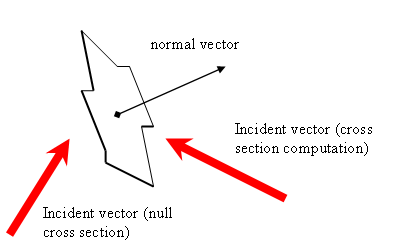User Manual 4.0 Facets : Différence entre versions
(Page créée avec « ====Definition==== A facet is a surface defined by its area and a normal vector, no supposition made of its exact shape. From those information, it can compute its cross s... ») |
(Aucune différence)
|
Version actuelle en date du 4 avril 2018 à 08:53
Definition
A facet is a surface defined by its area and a normal vector, no supposition made of its exact shape. From those information, it can compute its cross section seen from any incidental vector. A facet is visibile only from one half-space : the cross section computed is not null only if the dot product with the incidental vector is negative.
It shall be used to describe a spacecraft geometry in cross section computations for force models.
Implementation
This class implements the CrossSectionProvider interface. Please refer to the Javadoc for a complete list of public methods.
Instantiation
The Facet class is built from its area and normal vector :
Vector3D normalvector = new Vector3D(1.0, 5.6,-3.2); CrossSectionProvider facet = new Facet(normalvector , 5.0);
Keep in mind that normal vector should represent the outside of your facet. For example, drag will only be computed when normal vector takes the wind.
Usage
The Facet class proposes basic methods to get its area and normal vector.
It also provides the method getCrossSection (CrossSectionProvider interface), that shall be used this way :
Vector3D incidentialBeam = new Vector3D(7.0,-2.0, 8.0); double crossSection = facet.getCrossSection(incidentialBeam);
The result is not null only if "incidentialBeam " dot product with "normalvector " is negative.
